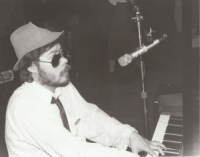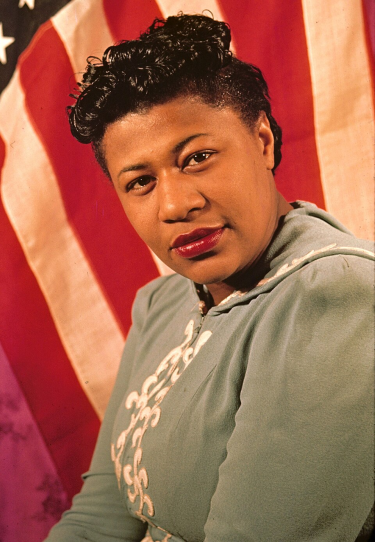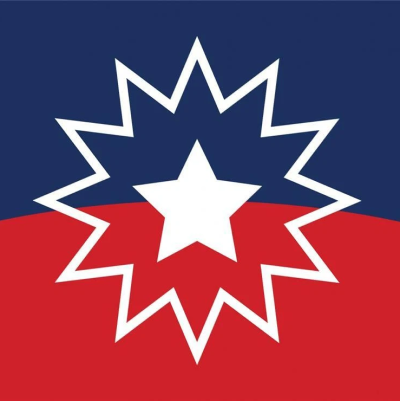.
.
“Bella by Barlight,” a story by Steve Young, was a short-listed entry in our recently concluded 54th Short Fiction Contest. It is published with the permission of the author
.
.
photo by-crosspraha- / CC BY-SA

.
Bella by Barlight
by Steve Young
.
___
,
…..The Pocono Lounge, in the basement behind the double doors on Temple and Broadway in downtown Los Angeles, was where, at age eighteen, I first became acquainted with “Stella By Starlight.” One night some drunk put the music up on the stand, but he had a speech impediment or was not long off the boat and couldn’t speak English too well. He called it “Bella By Barlight,” and the name stuck. At the time, we played it straight through from beginning to end, with me yelling out the changes to Fatso Wong Louie, my bass player, while Noky Mitsumi faked it with brushes. It was an unusual tune, with a touch of chaos to it and intrigued me, so, tucked in the back pocket of my tux, I took the music home that night and tinkered with it in my spare time.
….. The owner, Jimmy Lang, treated us badly, paid us peanuts, took to calling me his Number One Son, which would have gravely offended my dead parents, as I was Japanese, not Chinese. But what did I care back then, at eighteen? All you had to do in those days was point me toward a piano and I’d start playing, out of nervous habit, if nothing else. Occidentals had strange, demeaning ways but so did Orientals, especially the Japanese. We had Pearl Harbor to remember, too. Every year, December 7 would roll around and I’d want to hide under a rock.
….. Besides, Lang’s place was irresistible to an eighteen year old. Lang had it tricked up like a bordello, with no place to rest your eyes on the walls or the floor or the ceiling that didn’t remind you of sex: oils of nude women lounging on couches, in stuffy, gilded frames, paintings of bowls of fruit, with phallic bananas and voluptuous, round melons above upside down triangles of grapes, wild animals cuffing playfully in the veld, and low-lit street corner scenes with the women in bright red lipstick always half in the shadows of dark buildings, half in the garish light of a lamppost.
….. The bar consisted of three sides of a square, with a great oak top with Indianhead nickels and playing cards beneath the shellac and three-legged wooden stools in front. The counter was attended by a bartender per side, each of them aproned, bald, terse and harried. And everywhere, cigarette and cigar smoke drifted in a gray/blue cloud above our heads like poison gas. There were Boa feathers draped around the room, on the paintings and barrel taps and the Bosendorfer upright. For all I knew, it might have really been a brothel. Somewhere close by, behind some door, there could have been an even more inner inner sanctum. It would occur to me not without a trace of pleasure, from time to time: I’d become Kenneth Agaki, whorehouse pianist.
…..The patrons were all tone deaf, every last one of them, Oriental or Occidental. Maybe alcohol did that, especially gin, I noticed, or maybe it was all that sex or the reek of it in the air. They came in slick and primped, past Mr. Gee the Chinese doorman, the women sequined, pinned, bobbed, the men buttoned up, tidied up, in slate gray or pinstriped suits. All of them were undressed by the gin. The women slatternly, crude and loud; the men boisterous, belligerent, sleazy, on the edge of violence. It was as if their animal selves beneath the finery rose to the surface, took over, like a ventriloquist’s dummy taking over the body of the ventriloquist, emitting shrill chatter, and high artificial soprano laughter. All night they’d revolve drunkenly on the dance floor, and request numbers. I’d look deeply into their torsos while they made their appeals to me. They wanted to hear only the most popular tunes, of course, the real lemonade music, Tin Pan Alley crap: “Oh Johnny Oh”, “A Sunbonnet Blue”, “A Sentimental Gentleman from Georgia.”
…..We’d play and play, through it all, above and below the racket of those voices yakking at us and around us and nobody really listening. We’d play with ties and tuxes on and good-natured smiles. The corseted torsos approached and receded, and we’d sometimes play “As Time Goes By” eleven or twelve times a night. Noky never could hold his liquor, and by the sixth set he’d start dropping bombs in the middle of slow numbers, but nobody noticed or cared but me, and by that time of night I didn’t really care either.
….. One night a man wearing a brown and yellow checkered vest over a large stomach threatened to punch my lights out if I didn’t play “Down By the Sheltering Palms.” He shouted over the din into my ear that it was for his girl, who used to live in Florida. I tried to explain that I didn’t know the song, had never heard of it, but that just made him mad. He was smoking a cigar, a foul-smelling thick black tube, glowing red in the dark, and it almost burned a hole in my tux, that’s how close he was to me. His face was pock-marked and puffy and his hair had receded to a coil of gray curls at the top of his head. He smelled of gin and tobacco and spice cologne and something else underneath so diseased and rank I almost gagged.
…..“It’s for my baby, you slant-eyed bastard. She’s standing over there waiting to dance with me, see, and if you don’t play it, I’ll look like a dunce and she won’t go out with me again.” I was used to hearing biographies like this a dozen times or more a night, but this guy I couldn’t fix up, even if I’d happened to know the damn song. He was a loser and both of us knew it and she probably already knew it too, and there wasn’t much else to say about it. Out of curiosity, I glanced around his bulk, to find out what she looked like and also to stall for time.
….. There she was, alright, not ten feet away. She was Filipino, very young and tiny-boned, with olive skin, shiny dark hair. She wore a sleeveless flowered dress that stuck out on account of its ugliness; she looked like one of those mail-order brides, in fact. She smiled at me sweetly, shyly, revealing the gap between her two front teeth. I think it was the gap I fell in love with, or the ugly dress, or the smile; I don’t know what it was exactly but all breath left me and I found myself staring at her, too long. Her boyfriend finally tapped me on the shoulder, hard. I could feel the heat of his cigar in my ear.
…..“Hey, Chinaman, don’t take a picture or nothing.”
….. “She’s beautiful,” I blurted out.
….. “Yeah,” he replied heavily, as if the fact didn’t make him happy, not happy at all.
…..We finally settled on the “Miami Rag,” the only song about Florida I knew, and he bounced her clumsily around the floor for a few minutes, like he was holding a ragdoll, and then disappeared with her into the crowd. I forgot about them until during a break, on the way to the can, I saw them sitting awkwardly by themselves around one of the tiny round black tables in back. He waved his arm toward me, a sweeping, drunken gesture I was inclined to ignore. I made it a rule not to mingle with the patrons if I could avoid it. But she was there, in her flowered dress, smiling that sweet, shy smile. So I went over and said hello.
….. “You play beautiful,” she said to me, in a formal, polite way that made it sound as if she’d practiced the words. I introduced myself. She said her name was Maria. His, it turned out, was Frank.
…..Neither said anything about pulling up a chair, so I stood over them and the silence grew in a few seconds until it was about to go malignant. Frank said nothing, but there was something in the way he looked at me that made me think he wanted me there, desperately, like he was gripping my arm for dear life. More for his sake than my own, I said to Maria, “So you’re from Florida. Nice state, I hear.”
…..“Oh yes, nice state. Family there,” she said and smiled, revealing her gap again. Our eyes met and I thought I spied deep within those dark brown irises a flicker of both anguish and excitement. Save me, she seemed to be begging me, Save me from him.
…..But then she placed one of her lovely, tiny, olive-skinned hands on top of Frank’s giant, scaly, nicotine-stained paw and gave it a slight squeeze. In this small gesture, I saw the truth: she wasn’t repelled by this man. Rather, she was intoxicated by his American skin. She clung to it, as vulgar and mottled and diseased as it was. His worries were for nothing; she would never leave him. Or at least I could never take her away. She pitied me, and yearned only for her own transformation.
…..By then Noky was tapping the drums impatiently. Even Fatso Louie, whom I usually had to fetch from a broom closet in the back of the kitchen, where he went to smoke reefer between sets, was noodling on the bass. There seemed little else to say, anyway. I said goodbye to Maria and Frank and that was the end of that.
…..In the men’s room, over the urinal, scrawled in ball-point pen were the words: “For a good time, call Bambi,” and a phone number I almost had memorized. This time, I wrote it down on my palm so I wouldn’t forget.
At four AM, I went home to my second-floor walk-up on Los Angeles Street, stepping past the Chinese bums lying in the gutter and in the hallway. In my studio apartment, I picked up the phone and dialed Bambi’s number. I let it ring a dozen, two dozen times before I gave up. Then I practiced “Bella By Barlight,” in all twelve keys, on my Baldwin spinet, the soundboard muted by a wool blanket and two pillows. Over and over I played those dense, impenetrable chords, until the light of dawn crept through the cracks in my shades and I simply fell asleep at the bench.
.
___
.

Steve Young has an MFA in Fiction from Vermont College of Fine Arts. He has published nineteen short stories including in recent issues of the Saturday Evening Post, The Wild Word, Barren Magazine, and Woven Tale Press. Two of his stories have been nominated for the Pushcart Prize and BASS. Young grew up in Vermont and is an award-winning radio journalist (over 150 stories filed with NPR). He now lives and writes in Albuquerque, New Mexico. He plays jazz piano, is half-Japanese, half-Irish and is sight-impaired.
.
.
Listen to Bud Powell play “Stella by Starlight”
.
.
Click here for details on our upcoming Short Fiction Contest
.
Click here to read “A Failed Artist’s Paradise” by Nathaniel Whelan, the winning story in the 54th Jerry Jazz Musician Short Fiction Contest
.
.
.







































